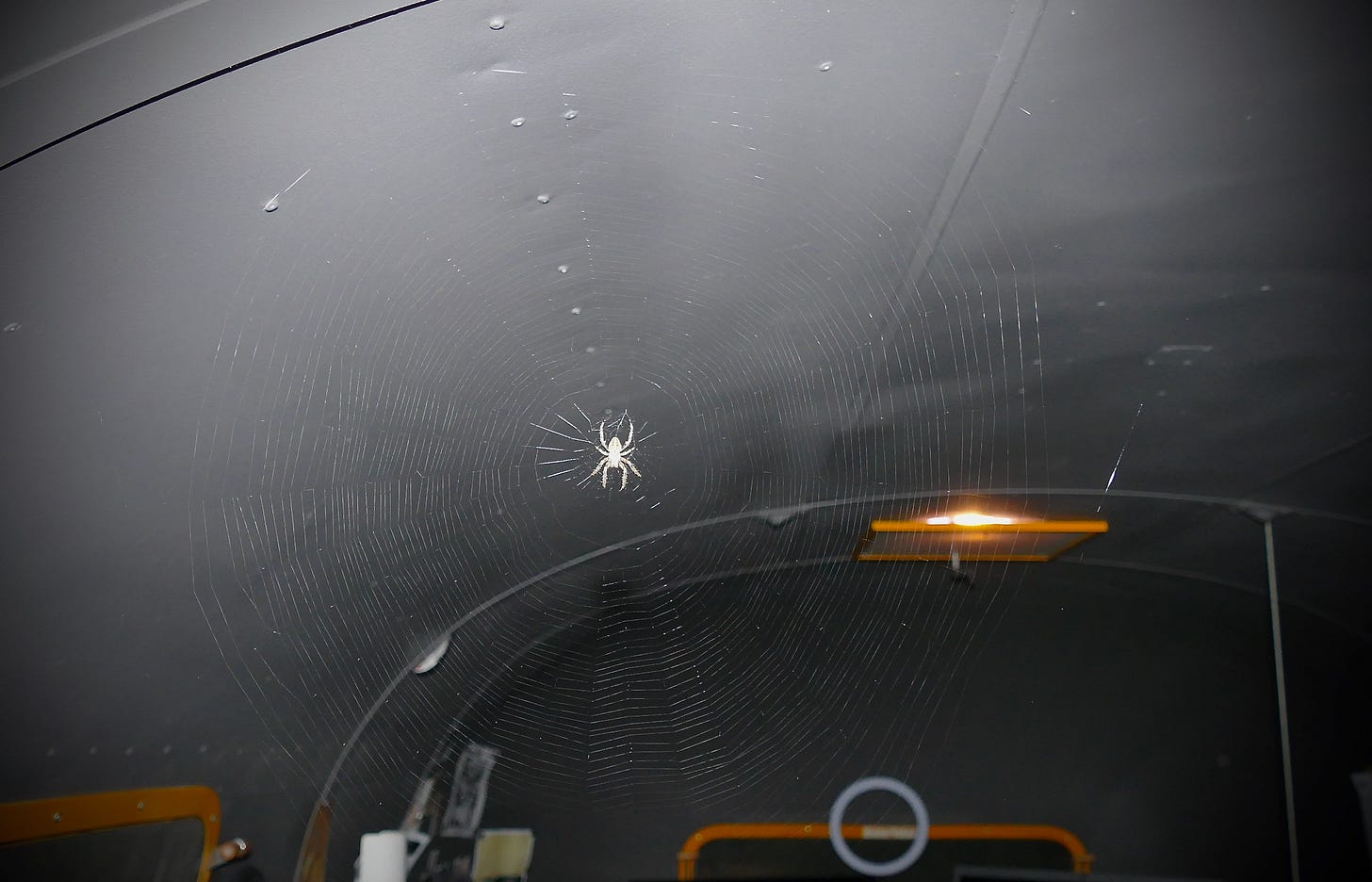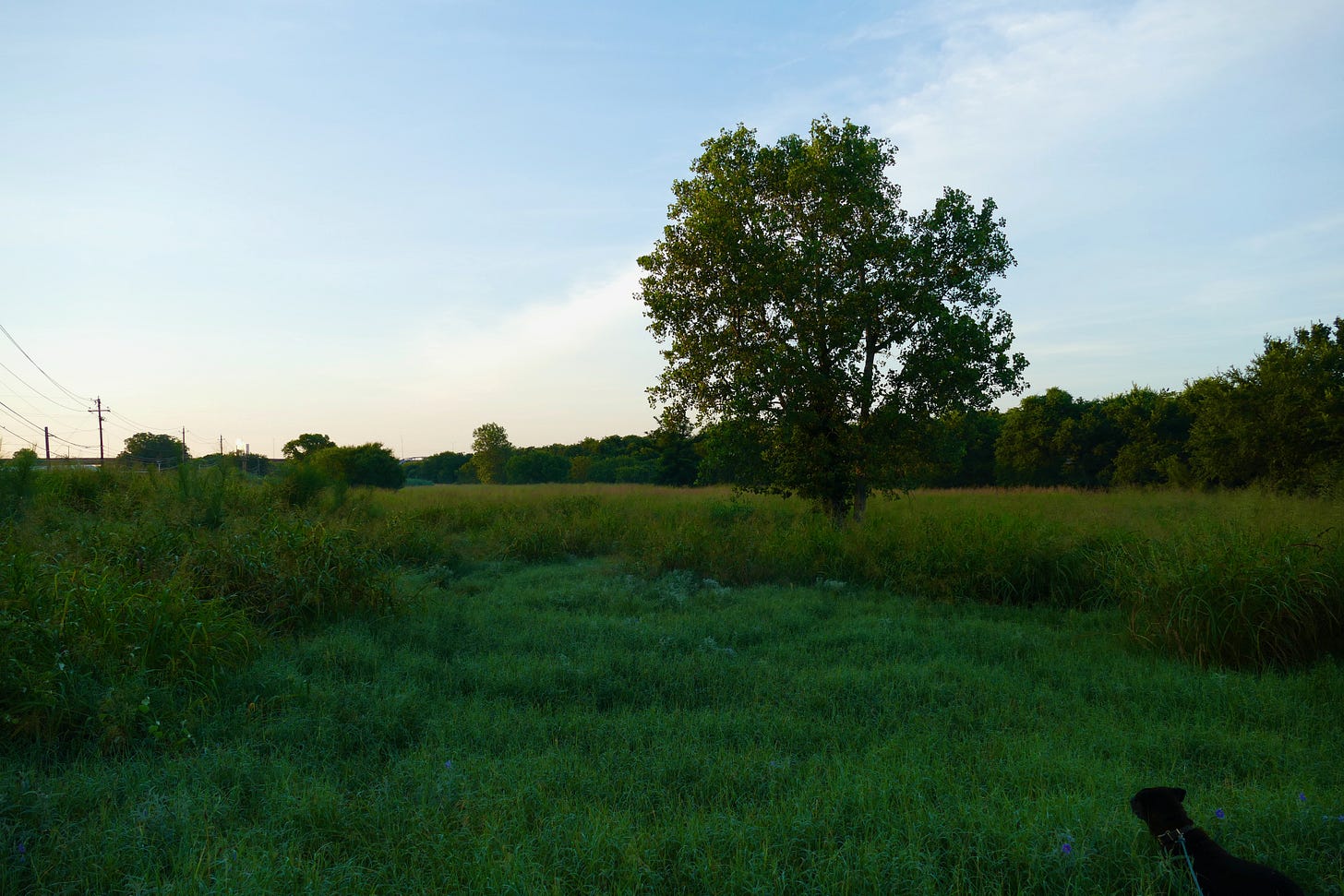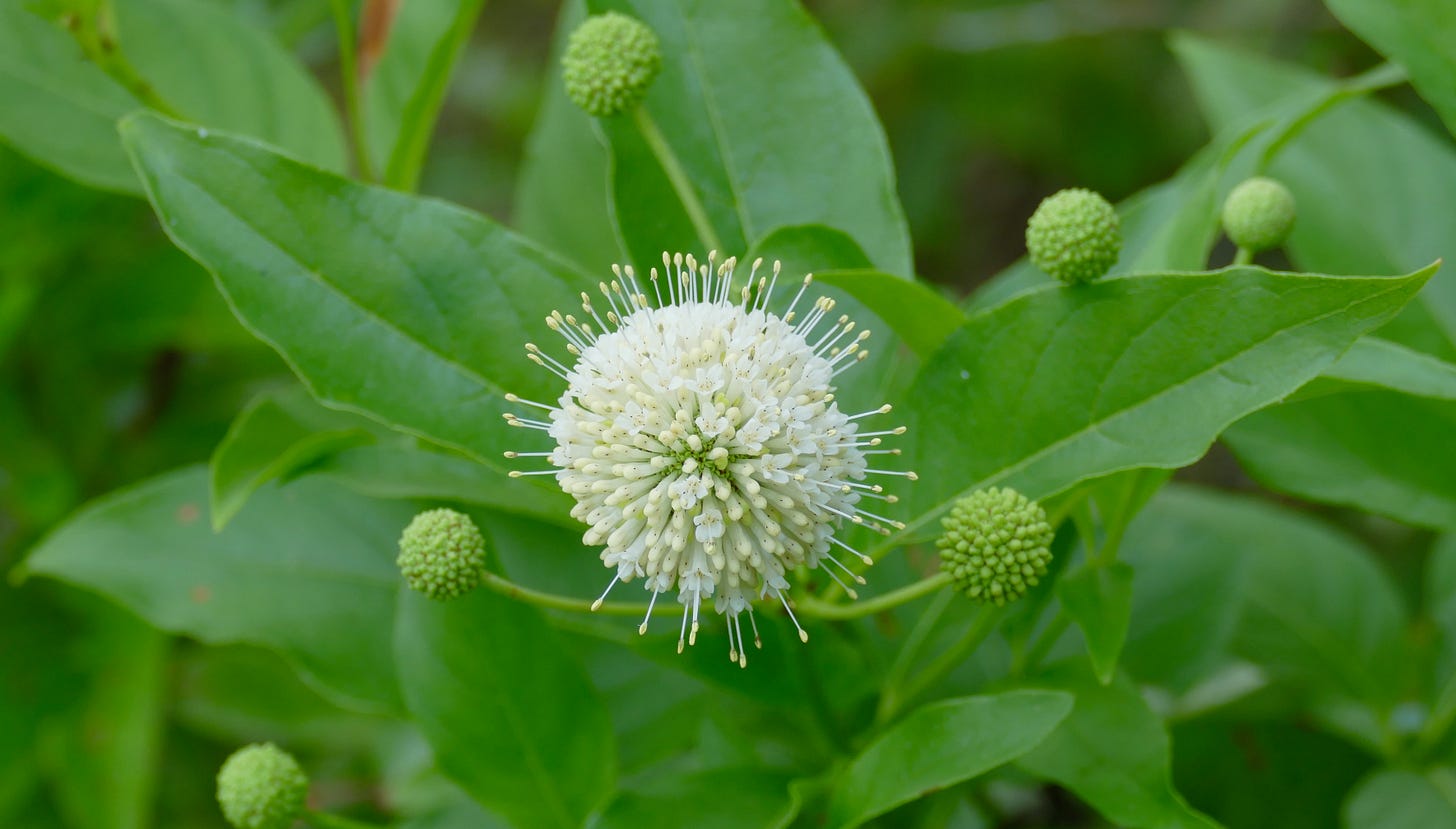Interdependence days
I didn't get far from my desk during the week, but I did get out with the dog every morning. Mostly on the sidewalk, where Thursday we came upon a mysterious tunnel some critter had dug under the chain link behind a warehouse, pointed in the direction of the dumpsters. If I were a better tracker, like Aragorn or Tom Brown, I could tell the story of exactly what did it and why.
Maybe one of the raccoons that come out of the culverts after we go to sleep, and somehow find the spots where the mama turtles have journeyed up from the urban river to lay their eggs deep into human space, as if that would make them safer.
With the expanse of a three-day weekend ahead of us, we set out on a more rugged excursion Saturday morning just as the sun had come up. We cut through the empty lot next door, a bit of infill at the edge of town where an overgrown and triple-locked chainlink gate is the unlikely portal between city and forest. The survey marks are all buried under the foliage and fallen trees now, but they still telegraph the inevitable future of that land. Earlier in the week we watched a crew knock down a grove of majestic pecans that had held out for decades on a triangular lot at the other end of the street, to make room for a new mixed-use project. I’d never seen someone use a backhoe to break a tree before. You could see the splintered remains piled up in the dumpsters.
The right of way behind the door factory is so overgrown these days as to be almost impassable, cluttered with the trunks of trees that fell on their own, barrier bamboo that escaped its bounds, and thick patches of the kinds of plants that get called weeds even though they’re native. Even the animals seem to have mostly given up getting through there until things dry out and die back, but we were determined, and so I followed our stealthy cur as she traced a kind of tunnel through the brush, crouched down to her level half the time. I wonder if someday the dudes at the gypsum supply yard will see me through the fence, crawling under the mustang vine and retama like some kind of man-vole.
We emerged at the edge of the field behind the dairy plant, where the May rains have brought Johnson grass so thick and tall that it was even harder to find a path there. One route led to a stable of refrigerated milk trucks that have repossessed the space their owner had been leasing to the techie workshare next door, an office project that got checked by Covid. I saw a Frankenheimer-grade black Audi parked in the visitors lot of the plant when I jogged by Friday afternoon, making me wonder which advance scouts of real estate capital may be angling to build the Towers on the Colorado on that industrial park that hides a real park.
We found our way over to the woods, which were full of young deer. Really young, where they look polka-dotted at a distance. They reminded me of the time we came upon one so young that it must have just been born, in a nook of cover above a drainage culvert right behind that truck lot, laying there like it hadn't even learned to walk, unattended and as vulnerable a creature as you have ever seen. One my dogs saw before me, in a failure of my own attention, and when I heard that squeak the dog toys try to imitate it was too late. Doing the thing humans have trained dogs to do, instruments of our dominion as the apex predators who never need to get blood on their hands.
That memory was banished by the time we found our way down to the river, as the sun was coming up over the tollway. We didn’t see many birds at first, not really surprising after the fireworks warm-up of the night before. But when we crossed the river and walked up the side channel, which is wetter than it’s been for many years, we found the night herons again, out even later than last week. The sun was at an angle that cast huge shadows of the vehicular bridge traffic against the green foliage where we stood, alternating with the intensely bright morning light, and we took a minute to soak in that slow-motion Anthropocene strobe.
When we got up around the north end of the island, one of the birds we had flushed had found a new spot on the opposite bank, right at the aperture of a new camp there in the shadow of the overpass.
Working our way back toward home, we came upon our first button bush bloom of the season, a native flower that flashes its summer corona with gusto but often in hard-to-find places.
And right around the corner, in the shallows along the rocky bank where they used to dredge gravel, a more mature green heron than the ones we saw last weekend was strutting through, finding the fishing easy.
When I first discovered this stretch of urban river, looking down from that overpass as I headed to the airport they had just made from the old Air Force base right after I moved here in the late 90s, I thought it was some unicorn remnant of a wilder past that had managed to survive the city’s expansion. It was only after I found myself living next to it that I learned it was, until very recently, the site of much more intense human use—mineral extraction, public roads, petroleum pipelines, sewer lines, and dump sites. I don’t have enough of the romantic left in me to see much redemption in its feral resurgence. It seems ephemeral, a momentary refuge in the long war between capital and climate. But it’s very existence, on the 245th birthday of the nation that colonized this territory, reveals how recent and provisional the erasure of the American wild really is. And how easy it would be to make more room for it to persist, in the space we share.
Long weekend reading (and watching)
In addition to retro Saturday matinees with our toddler, I’ve been checking out some of the films Criterion Channel compiled in the new Neonoir watchlist they made available this week. One is Blood Simple, the Coen Brothers’ (and Frances McDormand’s) first feature, which I saw with friends when it came out in 1984. Blood Simple was filmed in Austin, and there are a few early shots that give an idea of just how extensively we have overtaken the landscape since then. Including this opening shot that shows the Austin skyline from what looks to be not far from here:
And then this insane vantage from Mt. Bonnell, looking over the green hills of West Austin that are now cluttered with McMansions as far as the eye can see:
From a little later in local history, the City of Austin just premiered a new documentary about the environmental history of the area this newsletter spends most of its time roaming, specifically the fight in the 90s against the petroleum tank farm that six major oil companies operated for several decades in East Austin until it became apparent that it was killing the neighbors. It’s a powerful story of what organized and determined members of community can do to get justice. And instructive viewing that the site is ground zero for the next wave of gentrification.
Susana Almanza, who is featured in the story for her leadership in the fight around which her nonprofit, PODER, was formed, was recently appointed by the White House to its new Environmental Justice Advisory Council. I’m proud to be working with Susana, PODER and other neighbors and stakeholders on a new project to advocate for the protection, preservation and restoration of the urban Colorado River that flows through East Austin and eastern Travis County. There are lots of established institutions that work on matters related to the river, but few that focus on protecting its natural character, and none that organize the people and businesses who live or operate near the river. We’re planning to have our first organizing meeting of interested neighbors and stakeholders on July 24, so save the date if you’re local and interested, and watch this space for details (it will be at noon, via Zoom). In the meantime, you can check out our phase one website for more, or email me.
The new issue of Locus out this week features the interview I was lucky to have with editor Liza Groen Trombi, focused on my work as a science fiction writer but covering a lot of territory. A fun experience as a longtime reader of their interviews, and I love the headline and rewilded graphics they came up with for the piece. An online version of the interview will follow, but the print and electronic versions of the issue are available directly from Locus, and in bookstores.
Lastly, I was amused by this Fortean bit of local news from Tuesday’s paper out of Castroville, a town that Blood Meridian passes through. It’s funny, but also tabloid dystopian, when you think about ice falling from the sky on days that can melt rubber.
It was only when I read it the second time that I noticed the part about the new Texas State Climate Extremes Committee. Which turns out not to be a state project at all, but a swat team of NOAA scientists monitoring Texas like an alien planet. And with a sense of humor that comes through the clinical prose of their invisible literature as they describe the one that got away:
The first gargantuan hailstone reported to local media and NWS Austin-San Antonio was discovered south of U.S. Highway 90 in Hondo. The hailstone (Fig. 4) fell around 0040 UTC April 29 2021 (1940 CDT 28 April) and was estimated between 6 to 7 inch diameter by the finder. Dr. Matthew Kumjian of Penn State University used photogrammetry to estimate the diameter between 6.27 and 6.57 inches. Unfortunately, this hailstone was never measured with a ruler or similar device, and was ultimately used for margaritas according to the person who shared the images.
You can read the full report here.
Have a safe 4th of July and a great week. Field Notes will be on break next weekend—thanks for reading.
















I always learn from your Field Notes about a world in East Austin that I have not explored in my 42 years in this city. I have to say, you have a great advantage in being white and male. As a woman, I am hesitant to wander the wilds of Austin, but I still long to walk in places where there are no other people around. It wasn't always thus: When I was a child, I wandered wand rambled around the fields, patches of forest, and creeks near my home. Those were the days when a child could disappear for hours and parents wouldn't think twice about it. They knew I was out exploring. Your Field Notes bring back those memories. Thank you for posting the link to the documentary about the storage tanks in East Austin. The long war between capital and climate, indeed--could also be called the long war between capital and life. Countless cases of capital thriving on the illness and death of all life forms, life forms that are vulnerable and have little in the way of resources for defense. But of course. Who else? Carry on your good work. Thank you.
I look forward to your weekly field notes. I am reading a book that you might find interesting. “Islands of Abandonment; Nature Rebounding in the Post-Human Landscape “ by Cal Flynn. The author has observed sites around the world, including the US, that have been restricted for various human caused reasons. It’s a fascinating read. Thank you, Pam Murphy